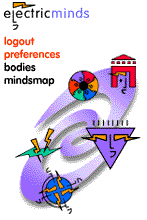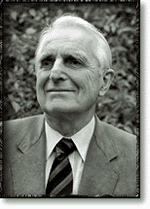
|

|

Part 1 of 3We often forget that people conceived and designed the tools we use, and that a window or a mouse was not predestined to be the computer metaphor of our age. In 1968, in front of 2,000 people, Douglas Engelbart introduced concepts that, for millions of people, now define the experience of using a computer. At the Fall Joint Computer Conference in San Francisco, he produced the first public unveiling of the "mouse," the "window," and the "point-and-click" metaphor. This Mother of Demos reverberated around the world, and permanently altered how we experienced computers. The most remarkable aspects of his vision were its clarity -- that computers could help everyday people work and think -- and the way he went about turning this idea into a reality. Doug's projects were funded by the same agency that funded the creation of the Internet. You could say that he worked on the "front end" -- the software that would allow the network to be experienced by non-experts. To a large degree, he was successful: hypertext, the web, and the icons that you click on were all inspired by Doug's work. Howard Rheingold's Tools For Thought gives some good background on Doug Engelbart, especially in Chapter Nine, "The Loneliness of the Long Distance Thinker." It is available online exclusively here at Electric Minds. Doug now leads The Bootstrap Institute. I spoke with him recently for an hour or so. We discussed his early days in computing, how he created his milestone metaphors, and whether today's world of web, Windows, and mice matches his expectations. Here's the first part of a three-part interview with Doug Engelbart, in his own words. David Bennahum: What was it about computing that drew you in? What had you read about computers that inspired you to think about them as a tool to help people think better? Doug Engelbart: Well, I'd read some things beginning in '48, just semi-popular things about how digital computers were emerging and some of the things they could do. And then I'd read a book called The Giant Brain. It was a popularized picture of what computers could do. You got the picture that a computer could read punchtape or punchcards, and likewise punch cards or paper tape or print on paper. I had enough technical background to know that if a computer could print on paper or punchcards, it could print anything you want to appear on a cathode ray tube. And if it could read those things, it could read contacts and different other instruments itself, so it could enhance what you were doing. So it could interact with you: what you did on the keyboard (or any other things you could wiggle or push), it could compute and do on the screen. I saw that this could let people start exploring brand-new kinds of symbology and knowledge portrayal. Then I realized: If people are equipped with similar workstations (whatever I was thinking of calling them, terminals; I'm not sure), then they could be tied to the same computer complex and could collaborate in brand-new ways. It didn't mean anything to me at the time whether people were ready to talk about that, or whether computers were ready to do it; that just became my commitment. So I quit my job and went to Berkeley, where they had a project to build a digital computer, and went into graduate school in the spring of '51. DB: And you studied computer science. Or whatever they called it then. DE: Yeah, it was just a freaky option in electrical engineering. I got a contract from ONR, The Office of Naval Research, to actually build a digital computer. So it was vacuum tubes and a magnetic drum. DB: Did you start building things at that point, or was it still totally theoretical? DE: It was just conceptual. We never got that computer going. The conceptual part -- I had to satisfy myself on doing some things with gaseous plasma discharge that were somewhat related to the way transistors work for my Ph.D. thesis. Then a faculty person from another department told me how advancement in a university environment goes. It's very much affected by your peer ratings, and also how you publish things. "And if you keep talking about something this wild and crazy, you will be an Acting Assistant Professor forever." DB: So did you stop doing that? DE: No. I left the university and went down to Stanford Research Institute (SRI), which was a separate not-for-profit, not really tied in with Stanford. I figured that if I could convince any management structure in the world about trying to do this, we could get the research going there. DB: And your mandate at SRI when they first hired you was? DE: Well: I had patents and such that came from my thesis, and having proven that I had done something, I thought I should sidle up to some research program that's going on there, and see if I could start working with them. So I did, and I got some more patents in the next few years. DB: Was this in computing? DE: It was a new kind of magnetic digital componentry. Working computers were not yet available I went to Stanford in '57. By '59 I had been thinking and talking about this to people quite a bit, and what I had persistently run into was that people would map it into their own ... well, later I learned the term "conceptual framework." Today they'd call it "paradigm." The psychologists would map it into the world of psychology (cognitive psychology was just beginning to emerge): "Well, son, there's a lot to the brain and all that, and you're just an engineer!" And other people listened to me and said, "Well, we're information retrieval specialists, and that's all you're talking about, using the computer for information retrieval." Much as I tried, I couldn't change it. So I went and got some research money from a specialty branch of the Air Force Research Agencies. I said, "Here's the thinking I've got, but somebody has to put it together." I had read a really interesting report from Rand Corporation that if you're going to do a multiple-disciplinary thing, you're going to find that the different disciplines you hire, the people you bring in will each bring an individual framework; what you have to do is build a common framework for them all, so that they can work together. So I started working on what turned out to be that "Augmenting Human Intellect" thing that came out several years later. DB: Right. The title was "A Conceptual Framework For the Augmentation of Man's Intellect." DE: Yeah. Or "Augmenting Human Intellect: A Conceptual Framework." DB: October 1962. And this was the proposal that eventually led to the IPTO money and the creation of your lab, the Augmentation Research Center. Can you tell me a little bit about that story? My understanding was that you had come up with this paper, and Bob Taylor was partly responsible for pointing the people with the pursestrings toward you. Is that true? DE: Well, he was interested, and he was at NASA at the time. But Licklider helped me get started initially. He was the first IPTO office director that bought into ARPA. He's the one who started giving me money. Taylor gave me some from NASA the next year, which helped. DB: Do you know how Licklider came across the paper? DE: Well, I was there knocking on his door. DB: What did you do? Did you go to Washington to meet with him? DE: Essentially sent stuff in to say: "Here's what I'd like to do, and here's the report, and here's a proposal." DB: From what I've heard about Licklider, it seems he was pretty open-minded. DE: Yeah. He had written a paper called "Man-Computer Symbiosis." My proposals had struck out a number of times among the government agencies. One of them said they'd send a site-visiting committee, and they later sent back: "We think it's a very interesting proposal you have, but since it would involve quite a lot of advanced computer programmers and since you're way out there in Palo Alto where there aren't any advanced computer programmers, we can't justify giving you the money." DB: But when Licklider saw the paper, he felt like you had a proposal that matched his vision in some sense? DE: Since he was advertising what he wanted to do, he really had to give me a try. But since it was "way out there in Palo Alto," as the saying goes, I'm pretty sure, from things I've heard from some of his compatriots at the time, that he thought it had a low probability of maturing because it was "way out there, but what the hell; give the kid a chance." DB: How much money did they wind up giving you, do you think, during the course of the project? DE: I think there was $13 to $14 or $15 million over the next 12 or 13 years. DB: That seems like a fair sum. DE: Well, it started out slow and bumpy, but by 1970 it got in gear. And then suddenly in 1976 it was judged that we were going on the wrong path. It was suddenly removed. DB: If you were to recreate the project now, how would you describe what you proposed and why they funded it? What was your idea? DE: The proposal was to start building an interactive system that we'd use for our own work, and then to evolve it. And the hypertext concept -- that was something Ted Nelson named years later. But I think what he was talking about is just linkage. From that Framework paper the concept emerged that you don't augment people with technology alone, but with technology and language and methods and skills and all sorts of things. You have to look at the whole system, if the technology part is going to erupt as much as it is. So this led me to thinking, well, there are a lot of surprises in the human-systems side. Where would we aim to explore and dig out first? It just seemed to me to be language, and the ways of externalizing your thought processes, versus symbolic language. And what are the new things you can do with that with the help of computers? You can structure it; you can do all kinds of things, including making exclusive citation interlinkage. Anyway, we built all that. Click here to read Part Two of David Bennahum's interview with Doug Engelbart. |
windwalker said: It seems to me that we should address the needs of our educational system using the net as a highway to provide the needed classes. I envision a combination of television, computer and in-class lectures that will offer top of the line information to all, cutting away the need for holding some students back for lack of funds while giving the rich the better advantage of higher learning. Most Active Topics: Topic 7 Cybernetics and Psychology Topic 3 Introducutions: Please introduce yourself here. Topic 17 FYI: Fallback Plans | |||
|
Doug Engelbart "If you're going to do a multiple-disciplinary thing, you're going to find that the different disciplines you hire, the people you bring in will each bring an individual framework; what you have to do is build a common framework for them all, so that they can work together." "You don't augment people with technology alone, but with technology and language and methods and skills and all sorts of things. You have to look at the whole system, if the technology part is going to erupt as much as it is." | ||||
Also in InterMinds: David Shenk Doug Engelbart Doug Engelbart | ||||
|
|

